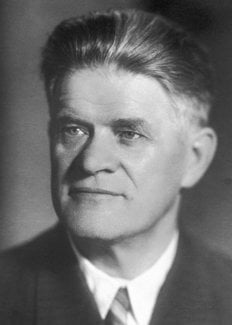Pavel A. Cherenkov
Biographical

Pavel Alekseyevich Cherenkov was born in Voronezh Region on July 28, 1904. His parents, Aleksei and Mariya Cerenkov, were peasants. He graduated from the Physico-Mathematical Faculty of Voronezh State University in 1928, and in 1930 he took a post as senior scientific officer in the P.N. Lebedev Institute of Physics in the U.S.S.R. Academy of Sciences. He was promoted to section leader, and in 1940 he was awarded the degree of Doctor in Physico-Mathematical Sciences. In 1953 he was confirmed in the academic rank of Professor of Experimental Physics, and since 1959 he has controlled the photo-meson processes laboratory. He has taught in institutes for higher learning for fourteen years.
It was in 1934, whilst he was working under S.I. Vavilov, that Cerenkov observed the emission of blue light from a bottle of water subjected to radioactive bombardment. This “Cerenkov effect”, associated with charged atomic particles moving at velocities higher than the speed of light, proved to be of great importance in subsequent experimental work in nuclear physics and for the study of cosmic rays. The Cerenkov detector has become a standard piece of equipment in atomic research for observing the existence and velocity of high-speed particles, and the device was installed in Sputnik III. He has shared in the work of development and construction of electron accelerators and in investigations of photo-nuclear and photo-meson reactions.
Cerenkov was awarded State Prizes in 1946 (with Vavilov, Frank, and Tamm) and in 1951.
In 1930 he married Marya Putintseva, daughter of A.M. Putintsev, Professor of Russian Literature. They have a son, Aleksei, and a daughter, Elena.
This autobiography/biography was written at the time of the award and first published in the book series Les Prix Nobel. It was later edited and republished in Nobel Lectures. To cite this document, always state the source as shown above.
Pavel A. Cherenkov died on January 6, 1990.
Nobel Prizes and laureates
Six prizes were awarded for achievements that have conferred the greatest benefit to humankind. The 14 laureates' work and discoveries range from quantum tunnelling to promoting democratic rights.
See them all presented here.
